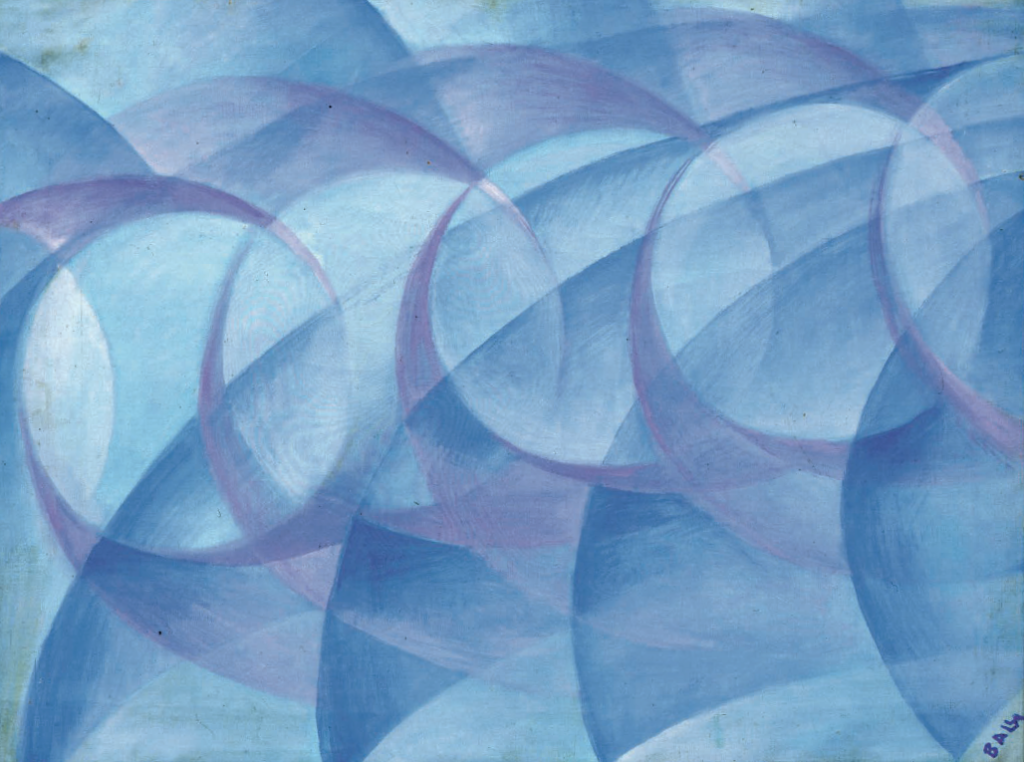Orbite celesti
Celestial Orbits
Artist Giacomo Balla
1913
Accession year before 1983
Oil on canvas, 60 x 80 cm
Signed on the front, bottom right: “Balla”; inscription on the back, bottom right: “Orbite celesti Balla”
Collection Fondazione Francesco Federico Cerruti per l’Arte
Long-term loan Castello di Rivoli Museo d’Arte Contemporanea, Rivoli-Turin
Inv. no. CC.13.P.BAL.1914.A65
Provenance: Private collection, Turin.
Exhibitions: [Rome 1968 (p. 47 note 26)]1; Alba 2016-17 (p. 162, no. 76).
Bibliography: Drudi Gambillo, Fiori 1958-62, p. 93, no. 113; Lista 1982, p. 195, no. 309; Milan 2008c, p. 63; Christov-Bakargiev 2021, vol. II, p. 654.

The heavenly bodies and cosmogony were a lifelong passion of Giacomo Balla, an acute observer of his era and the wealth of new horizons opened up by the great discoveries that were to revolutionise mankind’s relations with the universe and its laws.
The heavenly bodies and cosmogony were a lifelong passion of Giacomo Balla, an acute observer of his era and the wealth of new horizons opened up by the great discoveries that were to revolutionise mankind’s relations with the universe and its laws. An amateur astronomer, he read works of popular science, especially those of Camille Flammarion and Giovanni Schiaparelli, and observed the stars from the long balcony of his home in Via Parioli, sharing his awe at the immensity of the firmament with his daughter Elica. “Astronomy was the first thing he taught me, even before painting. He showed me the steady light of the planets. Venus, Mars, Jupiter, Saturn […] He was fascinated by the mystery of light and life in the starry universe.”2
Balla also investigated this mystery through art in an attempt to capture all the poetry of the eternal motion of those distant worlds on canvas. While cosmic space was first addressed with La Costellazione di Orione (Orion Constellation) in 1910, it was in the works of 1913-14 on orbital trajectories, vortices and the transit of Mercury across the face of the sun that he was to capture the sense of universal motion, daring formal translations of the “poetry of the cosmic forces” of which Marinetti wrote in Lo splendore geometrico e meccanico e la sensibilità numerica. The underlying logic stems directly from Balla’s previous experiments in the field of terrestrial motion, from the lines of speed of racing cars to the flight of swallows. He challenged the universe, entranced by the splendour and dynamism of the heavenly bodies, though the representation of linear motion in a finite space of time and the cyclical motion of infinity.
Balla addressed the rotation of the heavenly bodies in Orbite celesti (Celestial Orbits), representing the sequence of an orbital trajectory in a light, diaphanous space built up with almost transparent glazes that give the pigments a pastel-like texture. The composition guides the eye as it follows the continuous line of the motion of a heavenly body identically repeated from left to right across the canvas. The perception of movement is enhanced by the purple glow around the heavenly body, like the persistent wake of its passage, in contrast to the ethereal intangibility of the luminous material. The composition also presents other curved lines, whose propagation in space appears completely autonomous with respect to the orbital motion of the planet, as though to suggest the vaster orbits of other luminous bodies.
The work is not intended as an objective representation of empirical reality but rather reflects the feelings with which Balla contemplates the universe, whose great complexity can be grasped through intuition and sensory perception. The artist was to proceed further in this direction as from 1915 in pursuit of “abstract equivalents of all the forms and all the elements” for a “Futurist reconstruction of the universe”.
[Zelda De Lillo]
1 The painting does not appear in the list of works published in the catalogue. Nevertheless, note 26 on p. 47 indicates it as a version of the series dedicated to the theme of Spessori d’atmosfera. In the list of works exhibited for Balla luce e movimento (records of the Galleria L’Obelisco relative to exhibitions in 1968) there is a work entitled Studio per Orbite celesti, which could possibly be identified with the one now in the Cerruti Collection.
2 Balla 1983, p. 23.

